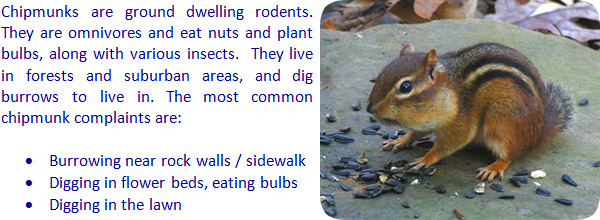- info@wildlifeanimalcontrol.com
Call us for help in your town
Wildlife Control Education
Where Do Chipmunks Store Their Food?

Need chipmunk removal in your hometown? We service over 500 USA locations! Click here to hire us in your town and check prices - updated for year 2020.
Chipmunks are an omnivorous animal and their diet consists of fruit, nuts, grain, berries, small frogs, insects, worms, bird eggs, and fungi. It has been known that these animals will sometimes even eat small mice. Although a chipmunk is an opportunistic predator to bird eggs and nestlings they are also very important mammals as prey to birds.
A chipmunk is known for storing their food so that they will have a large supply to eat throughout the winter. They begin storing their food at the start of autumn and have two ways they go about doing this. They will either store their food in one central location, known as larder hoarding, or they will store their food in several smaller stashes, known as scatter hoarding. The larder hoarding chipmunk will generally live in their burrows throughout the winter and will not leave until the spring time. They are easily and quickly able to transport foods they find to their caches using pouches found in their cheeks that allow them to carry large amounts of food at once.
Chipmunks play a very important part in their respective ecosystems. The gathering and transporting of seeds and nuts they do helps with the establishment of seedlings for a variety of plants. They also eat and collect a large variety of fungi and help to spread their spores around. Some fungi, like the truffle, have lost their ability to disperse their spores through the air because of mammals like the chipmunks. These particular fungi have co-existed and co-evolved with these mammals for so long that they only use mammals to disperse and, therefore, reproduce.
A chipmunk will have a burrow that can be quite expansive and will often be more than three and a half metres in length. They will have several well hidden exits throughout their burrows. Their burrow will have areas used for specific purposes such as a refuse tunnel and their sleeping quarters. They keep their sleeping quarters very clean by keeping all feces and food waste in the refuse tunnel. They also have an area assigned specifically for storing the food they have gathered and stashed for winter consumption.
Since chipmunks are able to sleep much better and longer than some of the other mammals. This is said to be because they sleep deep in their burrows and are well-hidden and protected from various prey. When in captivity chipmunks have been reported to sleep up to 15 hours every day. If this is also true for wild chipmunks this would mean that they are only active for nine hours a day.
Chipmunks are a very interesting animal and nearly all species of them can be found living in North America. There is only one known species of chipmunk that lives elsewhere in the world. The Siberian chipmunk can be found living in Asia. These animals are a smaller stripped squirrel and are categorized as either Tamias, Eutamias or Neotamias. Recently they have started only categorizing them as Tamias which is the Latin word for storer. There are numerous ways of spelling the word chipmunk but this spelling is the most commonly used and known.
You're here to learn how to get rid of chipmunks in your flower beds, yard, or house. This site is intended to provide chipmunk education and information, so that you can make an informed decision
if you need to deal with a chipmunk problem. This site provides many chipmunk control articles and strategies, if
you wish to attempt to solve the problem yourself. If you are unable to do so, which is likely with many
cases of chipmunk removal, please go to the home page and click the USA map, where I have wildlife removal experts
listed in over 500 cites and towns, who can properly help you with your nuisance chipmunk.

















